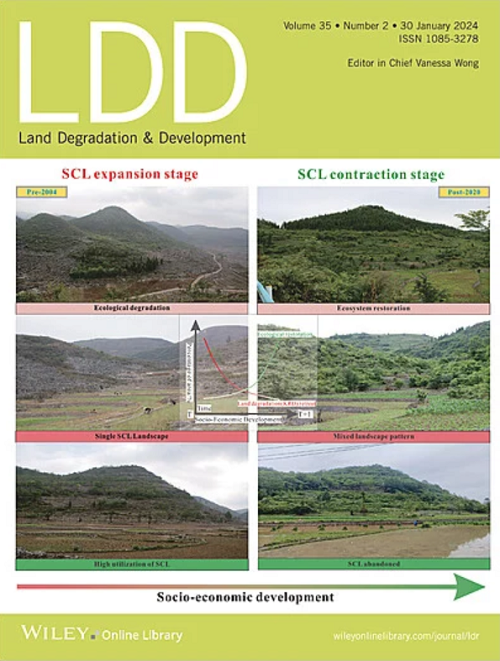放牧年限和环境对再生铀矿尾矿土壤碳的影响
IF 3.6
2区 农林科学
Q2 ENVIRONMENTAL SCIENCES
引用次数: 0
摘要
草原生态系统覆盖了地球陆地面积的三分之一以上,储存了全球10%-30%的土壤碳(C)。然而,这些生态系统面临着包括采矿在内的人类活动的重大影响。研究了怀俄明州原铀矿废弃地复垦草地土壤C的空间分布特征及相关环境因子。我们假设放牧时间和环境因素会影响土壤C水平。利用地理加权回归模型分析了1 ~ 100年自然草地和复垦草地在放牧管理背景下的地形、植被多样性、土壤性质和土壤C之间的相互作用。2022 - 2023年的数据显示,天然草地的总碳含量(1.2%-4.9%)始终高于复垦草地(0.8%-1.3%)。放牧1年的天然草地土壤C含量显著高于放牧100年的天然草地。复垦草地放牧1年的土壤C值低于放牧7年和14年的土壤C值。环境协变量系数的绝对值表明,放牧时间较短(~1年)的地区受生物和非生物因素的影响大于放牧时间较长的地区(>;7年)。研究结果表明,适度放牧可增加草地生态系统在放牧7年或更长时间内的恢复力,并承认地形、土壤和植被因素在提高土壤C浓度和制定可持续土地管理措施方面的作用。本文章由计算机程序翻译,如有差异,请以英文原文为准。
Impact of Grazing Duration and Environment on Soil Carbon in Reclaimed Uranium Mines Tailings: A Region Specific Study
Grassland ecosystems, which cover over one‐third of the Earth's land area, store 10%–30% of global soil carbon (C). However, these ecosystems face substantial impacts from human activities, including mining. This study investigates the spatial distribution of soil C and related environmental factors in reclaimed grasslands on former uranium mine sites in Wyoming. We hypothesized that grazing duration and environmental factors would influence soil C levels. Interactions between topography, vegetation diversity, soil properties, and soil C in the context of grazing management in both natural and reclaimed grasslands from a wide range of periods from 1 year to 100 years were analyzed using geographically weighted regression models. Data collected from 2022 to 2023 showed that total carbon was consistently higher in natural grasslands (1.2%–4.9%) than in reclaimed grasslands (0.8%–1.3%). Additionally, soil C was significantly higher in natural grasslands grazed for 1 year compared to those grazed for 100 years. In contrast, reclaimed grasslands had lower soil C in areas grazed for 1 year compared to those grazed for 7 or 14 years. The absolute values of coefficients from environmental covariates indicated that areas grazed for a shorter duration (~1 year) were more influenced by biotic and abiotic factors than areas grazed for longer periods (> 7 years). Our findings show moderate grazing increases the resiliency of grassland ecosystems when grazed 7 years or longer and acknowledge the roles of topographic, soil, and vegetative factors in enhancing soil C concentration and developing sustainable land management practices in rangeland conditions.
求助全文
通过发布文献求助,成功后即可免费获取论文全文。
去求助
来源期刊

Land Degradation & Development
农林科学-环境科学
CiteScore
7.70
自引率
8.50%
发文量
379
审稿时长
5.5 months
期刊介绍:
Land Degradation & Development is an international journal which seeks to promote rational study of the recognition, monitoring, control and rehabilitation of degradation in terrestrial environments. The journal focuses on:
- what land degradation is;
- what causes land degradation;
- the impacts of land degradation
- the scale of land degradation;
- the history, current status or future trends of land degradation;
- avoidance, mitigation and control of land degradation;
- remedial actions to rehabilitate or restore degraded land;
- sustainable land management.
 求助内容:
求助内容: 应助结果提醒方式:
应助结果提醒方式:


